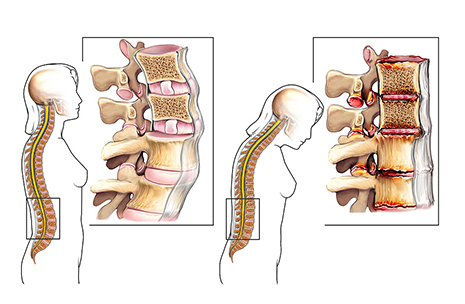
Abnormal Curvatures
- Kyphosis involves the upper back curving forward. The condition can create the form of a hump.
- Lordosis is also known as swayback. This is a deformity of the lower back, in which it curves inward instead of outward.
- Scoliosis is a frontal deformity in which the spine, when viewed straight on, curves to the left or the right. This curving ordinarily ends at the same time the skeleton stops growing but in adulthood, the curve can still progress slightly, often as a result of disk degeneration.
Causes :
The following conditions can cause lordosis:
- Achondroplasia: A disorder in which bones do not grow normally, resulting in the short stature associated with dwarfism.
- Spondylolisthesis: A condition in which a vertebrae, usually in the lower back, slips forward.
- Osteoporosis: A condition in which vertebrae become fragile and can be easily broken (compression fractures).
- Obesity: Or being extremely overweight.
- Kyphosis: A condition marked by an abnormally rounded upper back.
- Discitis: Inflammation of the disc space between the bones of the spine most often caused by infection.
- Benign (harmless) juvenile lordosis.
The following conditions can cause kyphosis:
- Abnormal vertebrae development in utero (congenital kyphosis)
- Poor posture or slouching (postural kyphosis)
- Scheuermann’s disease, a condition that causes vertebrae to be misshaped (Scheuermann’s kyphosis)
- Arthritis
- Osteoporosis
- Spina bifida, a birth defect in which the spinal column of the fetus does not close completely during development inside the womb
- Spine infections
- Spine tumors
Symptoms :
- Pain. For scoliosis, this pain may occur in the upper spine and the ribs.
- Feeling of being off balance or difficulty walking or standing. When the spine isn’t in correct alignment, the body and head aren’t either.
- Visible curve (hunched over). In kyphosis, in particular, the outer curve in the upper back may be noticeable. In scoliosis, one shoulder blade, or hip, may appear higher than the other.
- No symptoms. For some patients with mild deformities, the curves may not cause any symptoms.
Treatments :
- Abhyangam
- Choorna pinda sweda
- Patra pottali sweda
- Vata vyadhi chikitsa – Snehana, swedana, vasti
- Virechana
- Snehadhara
With some exercises and practicing yoga can improve one’s life

